Abstract
OBJECTIVES. Studies of the health effects of job strain have focused on morbidity and mortality as outcomes. This is the first study to examine the relationship of job strain to more comprehensive health status measures that encompass health-related quality of life. METHODS. In a national cross-sectional survey, 1319 working men and women, aged 18 through 64 years, completed a modified version of the Job Content Questionnaire that classified workers' jobs into four categories: high strain, passive, low strain, and active. Subjects also completed the Medical Outcomes Study Short-Form Health Survey and a health distress scale. Logistic regression analyses were employed that controlled for age, race/ethnicity, gender, and education. Both work and nonwork variables were included. RESULTS. Job strain was significantly associated with five of nine components of health-related quality of life: physical functioning, role functioning related to physical health, vitality, social functioning, and mental health. Job strain made a modest yet statistically significant contribution beyond the effects of chronic illness and psychosocial variables. CONCLUSIONS. The results provide justification for further investigating the role of job strain as an independent risk factor for health-related quality of life.
Full text
PDF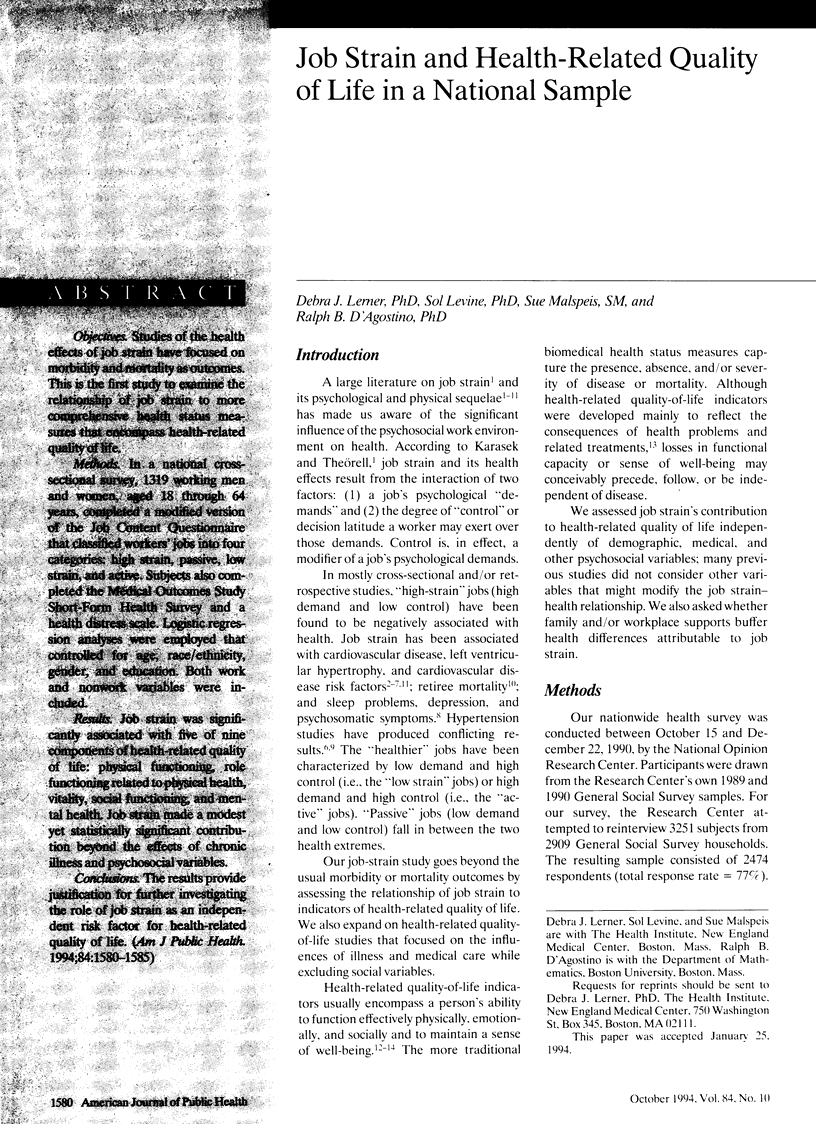
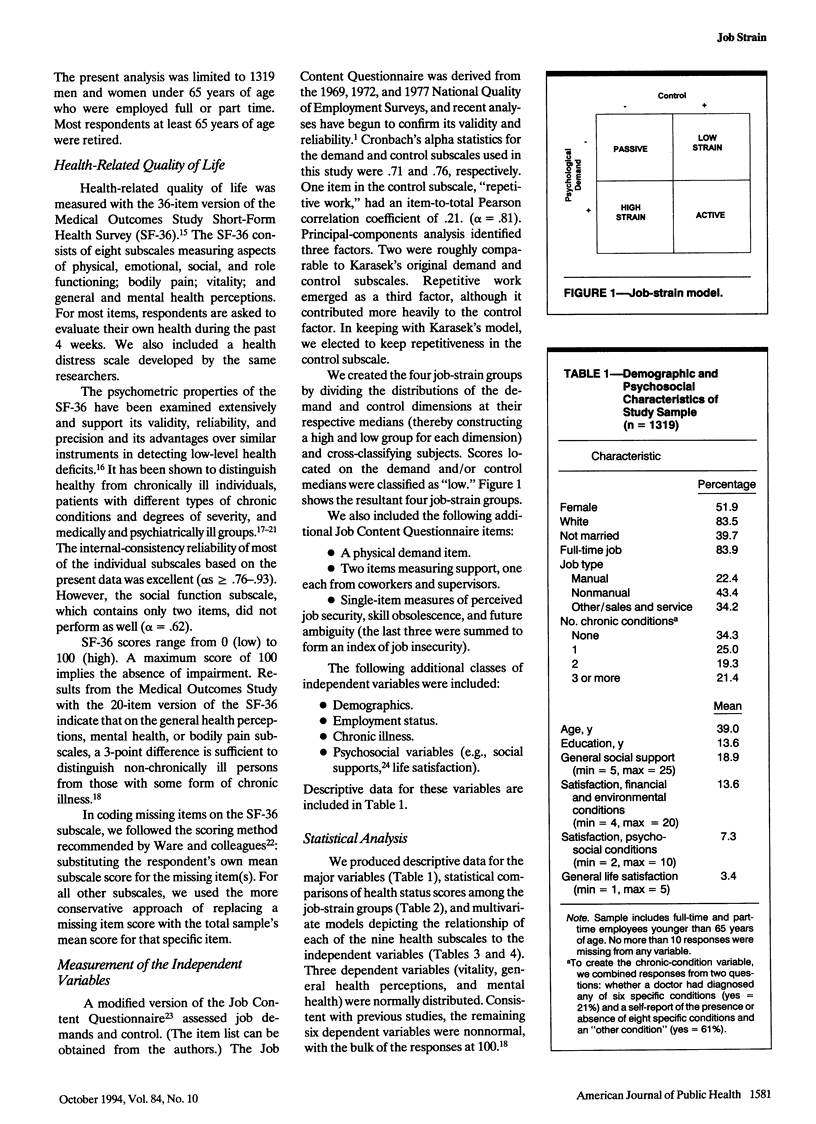
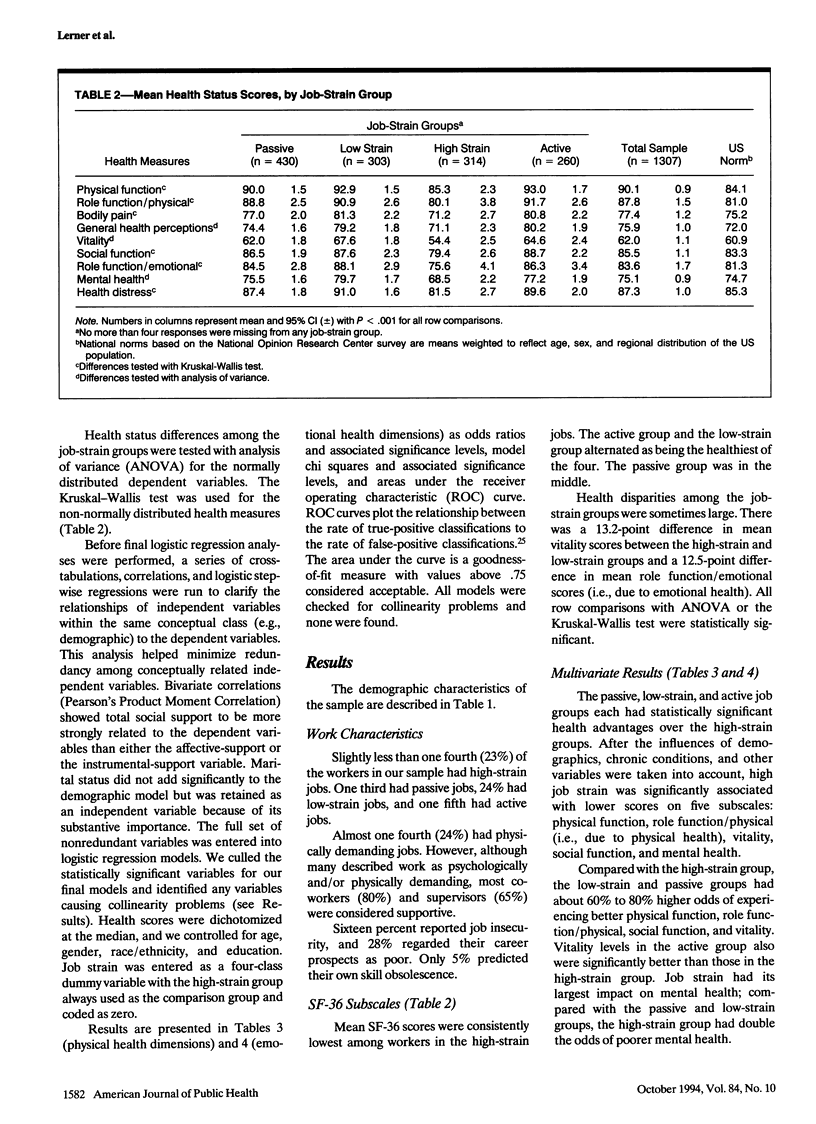
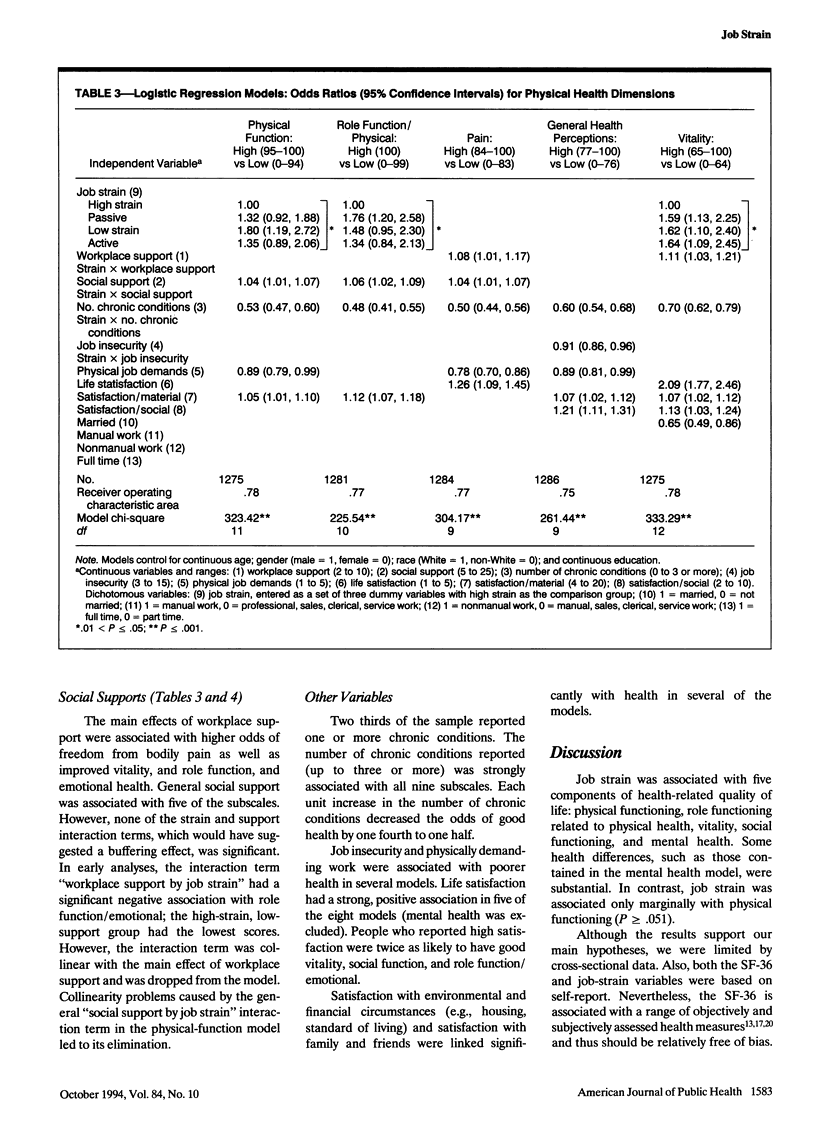
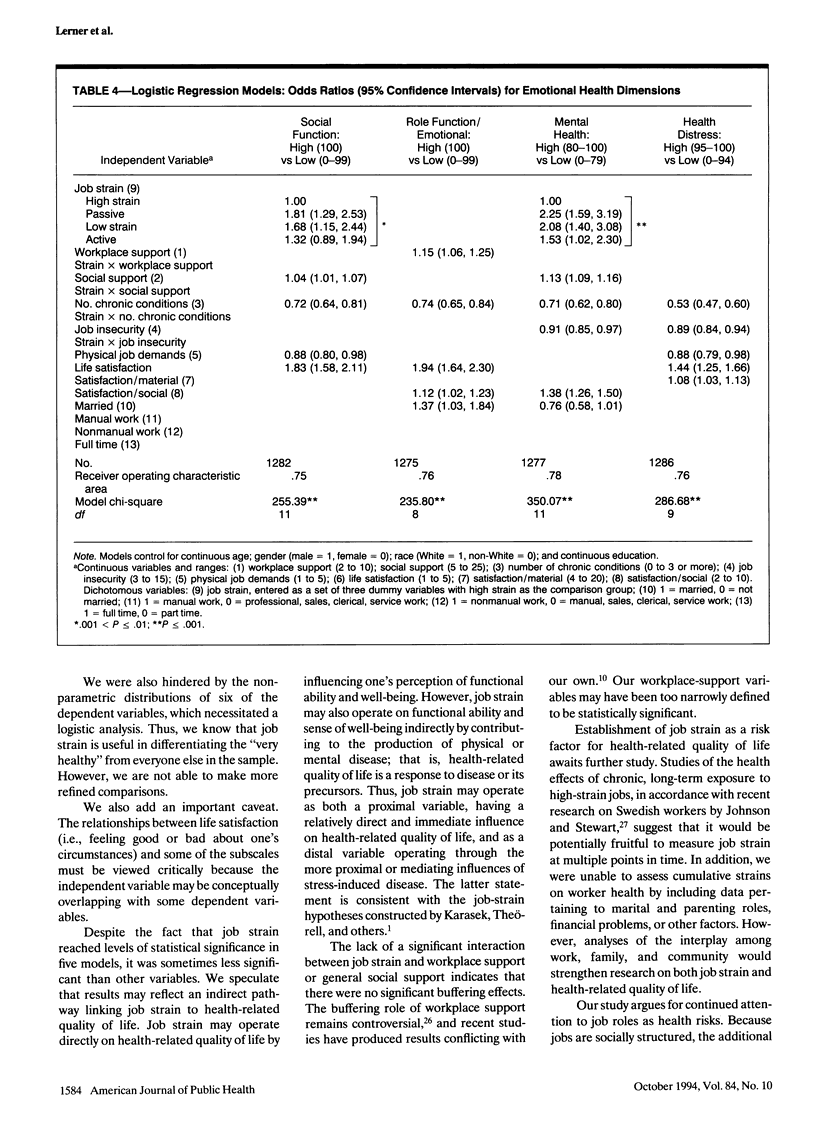
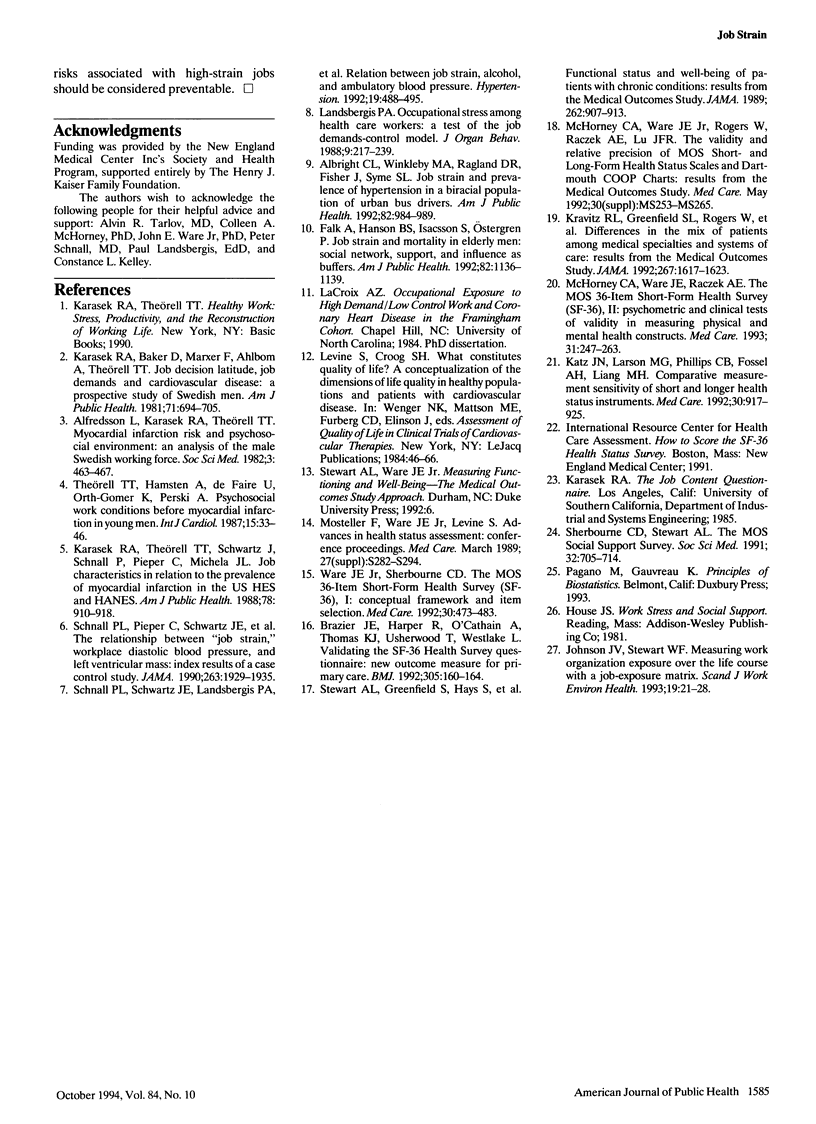
Selected References
These references are in PubMed. This may not be the complete list of references from this article.
- Albright C. L., Winkleby M. A., Ragland D. R., Fisher J., Syme S. L. Job strain and prevalence of hypertension in a biracial population of urban bus drivers. Am J Public Health. 1992 Jul;82(7):984–989. doi: 10.2105/ajph.82.7.984. [DOI] [PMC free article] [PubMed] [Google Scholar]
- Alfredsson L., Karasek R., Theorell T. Myocardial infarction risk and psychosocial work environment: an analysis of the male Swedish working force. Soc Sci Med. 1982;16(4):463–467. doi: 10.1016/0277-9536(82)90054-5. [DOI] [PubMed] [Google Scholar]
- Brazier J. E., Harper R., Jones N. M., O'Cathain A., Thomas K. J., Usherwood T., Westlake L. Validating the SF-36 health survey questionnaire: new outcome measure for primary care. BMJ. 1992 Jul 18;305(6846):160–164. doi: 10.1136/bmj.305.6846.160. [DOI] [PMC free article] [PubMed] [Google Scholar]
- Falk A., Hanson B. S., Isacsson S. O., Ostergren P. O. Job strain and mortality in elderly men: social network, support, and influence as buffers. Am J Public Health. 1992 Aug;82(8):1136–1139. doi: 10.2105/ajph.82.8.1136. [DOI] [PMC free article] [PubMed] [Google Scholar]
- Johnson J. V., Stewart W. F. Measuring work organization exposure over the life course with a job-exposure matrix. Scand J Work Environ Health. 1993 Feb;19(1):21–28. doi: 10.5271/sjweh.1508. [DOI] [PubMed] [Google Scholar]
- Karasek R. A., Theorell T., Schwartz J. E., Schnall P. L., Pieper C. F., Michela J. L. Job characteristics in relation to the prevalence of myocardial infarction in the US Health Examination Survey (HES) and the Health and Nutrition Examination Survey (HANES). Am J Public Health. 1988 Aug;78(8):910–918. doi: 10.2105/ajph.78.8.910. [DOI] [PMC free article] [PubMed] [Google Scholar]
- Karasek R., Baker D., Marxer F., Ahlbom A., Theorell T. Job decision latitude, job demands, and cardiovascular disease: a prospective study of Swedish men. Am J Public Health. 1981 Jul;71(7):694–705. doi: 10.2105/ajph.71.7.694. [DOI] [PMC free article] [PubMed] [Google Scholar]
- Katz J. N., Larson M. G., Phillips C. B., Fossel A. H., Liang M. H. Comparative measurement sensitivity of short and longer health status instruments. Med Care. 1992 Oct;30(10):917–925. doi: 10.1097/00005650-199210000-00004. [DOI] [PubMed] [Google Scholar]
- Kravitz R. L., Greenfield S., Rogers W., Manning W. G., Jr, Zubkoff M., Nelson E. C., Tarlov A. R., Ware J. E., Jr Differences in the mix of patients among medical specialties and systems of care. Results from the medical outcomes study. JAMA. 1992 Mar 25;267(12):1617–1623. [PubMed] [Google Scholar]
- McHorney C. A., Ware J. E., Jr, Raczek A. E. The MOS 36-Item Short-Form Health Survey (SF-36): II. Psychometric and clinical tests of validity in measuring physical and mental health constructs. Med Care. 1993 Mar;31(3):247–263. doi: 10.1097/00005650-199303000-00006. [DOI] [PubMed] [Google Scholar]
- McHorney C. A., Ware J. E., Jr, Rogers W., Raczek A. E., Lu J. F. The validity and relative precision of MOS short- and long-form health status scales and Dartmouth COOP charts. Results from the Medical Outcomes Study. Med Care. 1992 May;30(5 Suppl):MS253–MS265. doi: 10.1097/00005650-199205001-00025. [DOI] [PubMed] [Google Scholar]
- Schnall P. L., Pieper C., Schwartz J. E., Karasek R. A., Schlussel Y., Devereux R. B., Ganau A., Alderman M., Warren K., Pickering T. G. The relationship between 'job strain,' workplace diastolic blood pressure, and left ventricular mass index. Results of a case-control study. JAMA. 1990 Apr 11;263(14):1929–1935. [PubMed] [Google Scholar]
- Schnall P. L., Schwartz J. E., Landsbergis P. A., Warren K., Pickering T. G. Relation between job strain, alcohol, and ambulatory blood pressure. Hypertension. 1992 May;19(5):488–494. doi: 10.1161/01.hyp.19.5.488. [DOI] [PubMed] [Google Scholar]
- Sherbourne C. D., Stewart A. L. The MOS social support survey. Soc Sci Med. 1991;32(6):705–714. doi: 10.1016/0277-9536(91)90150-b. [DOI] [PubMed] [Google Scholar]
- Theorell T., Hamsten A., de Faire U., Orth-Gomér K., Perski A. Psychosocial work conditions before myocardial infarction in young men. Int J Cardiol. 1987 Apr;15(1):33–46. doi: 10.1016/0167-5273(87)90290-7. [DOI] [PubMed] [Google Scholar]
- Ware J. E., Jr, Sherbourne C. D. The MOS 36-item short-form health survey (SF-36). I. Conceptual framework and item selection. Med Care. 1992 Jun;30(6):473–483. [PubMed] [Google Scholar]


